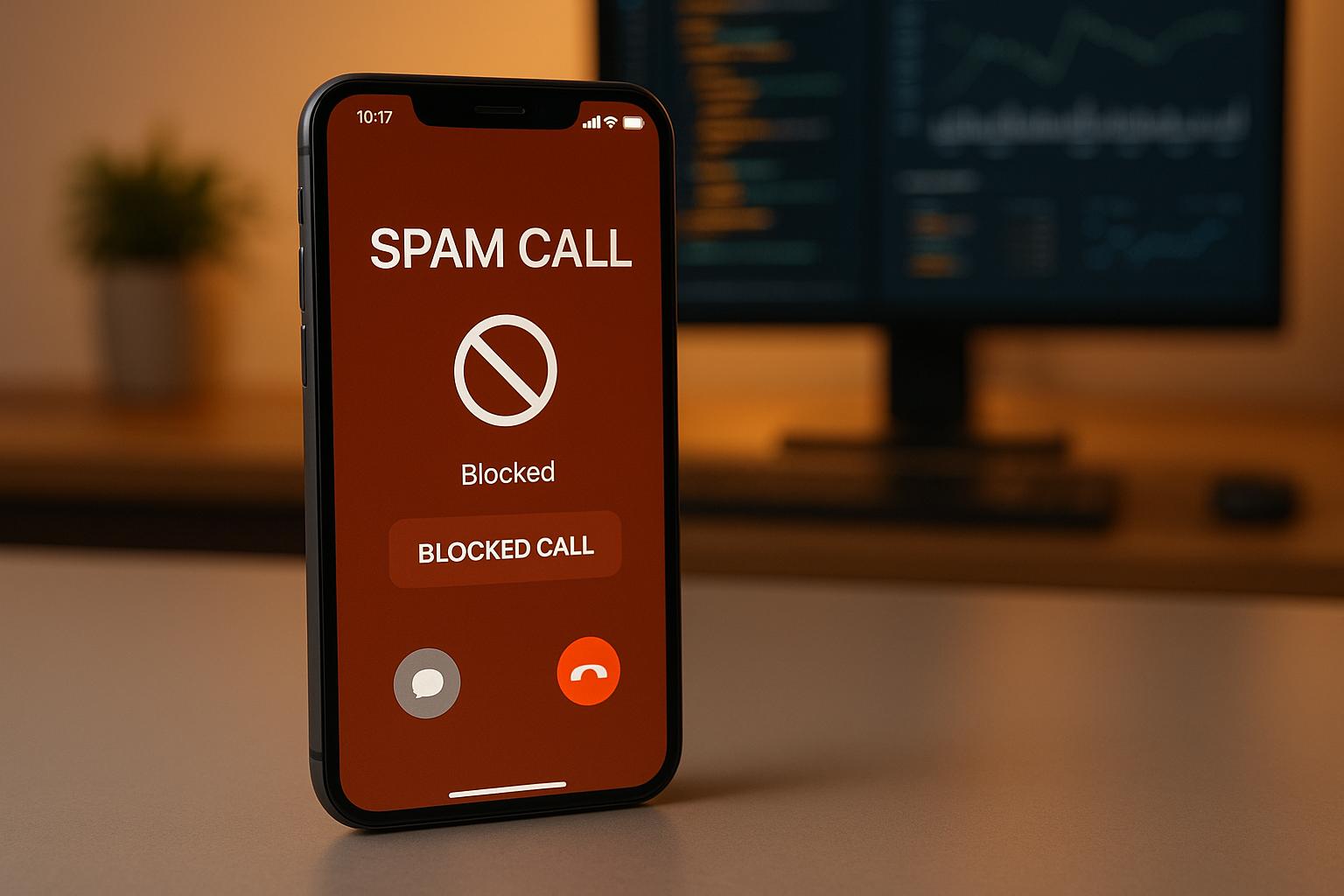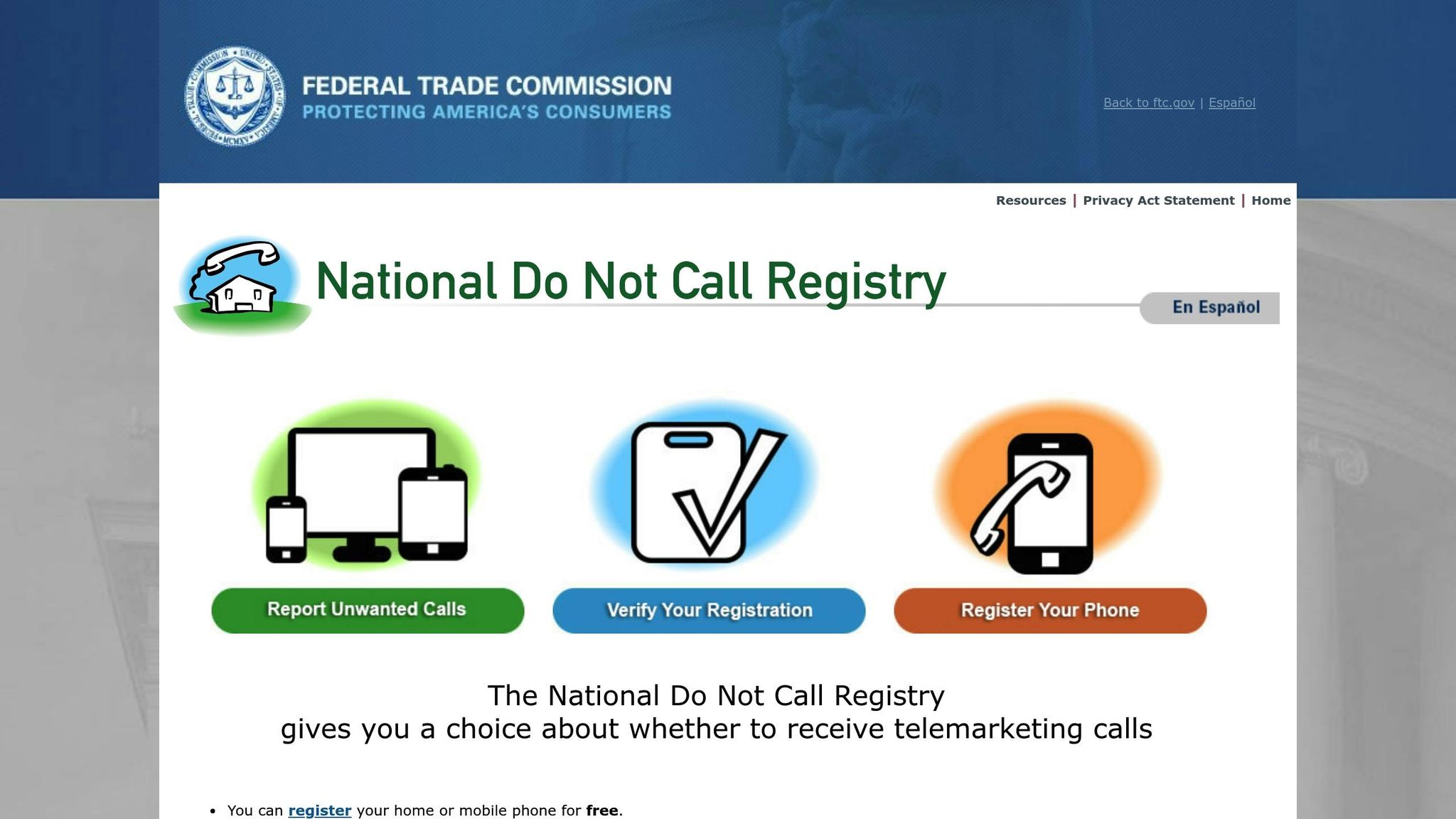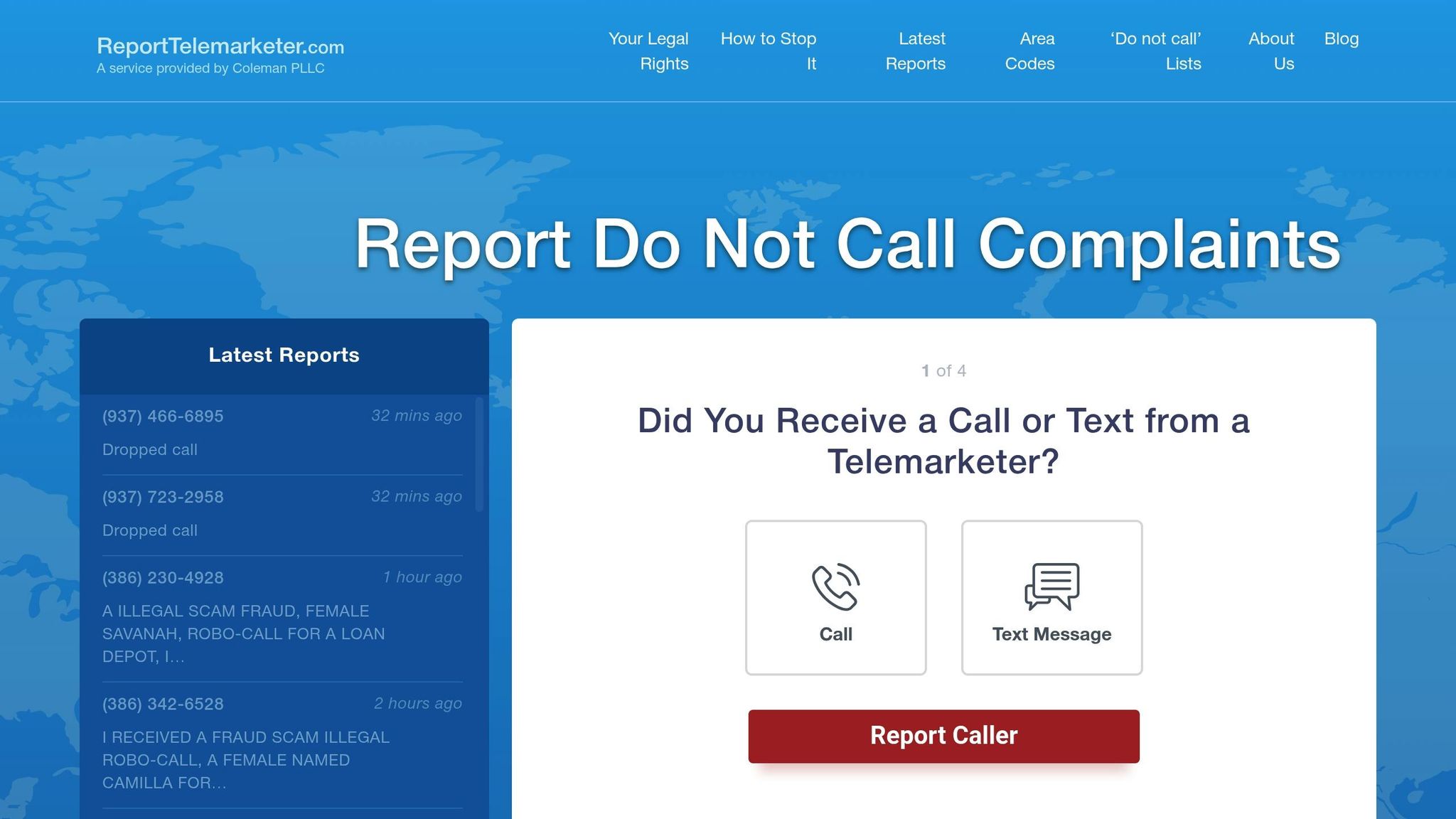
Robocalls are a growing nuisance, with billions of calls hitting Americans every year. Many of these are scams targeting vulnerable individuals, leading to financial losses and frustration. The Federal Trade Commission (FTC) is tackling this issue with a dual approach:
- Tech Partnerships: The FTC collaborates with telecom companies and tech developers to roll out solutions like call-blocking apps and STIR/SHAKEN protocols, which verify caller identities and block illegal calls in real time.
- Legal Enforcement: The agency files lawsuits, imposes fines, and works with other regulators to hold robocallers accountable.
These efforts are supported by consumer reporting platforms like ReportTelemarketer.com, which empower individuals to report unwanted calls and contribute to investigations. Together, these strategies aim to reduce robocalls and protect consumers.
Fighting the Scourge of Illegal Robocalls
FTC Technology Partnerships for Robocall Prevention
The FTC tackles the robocall problem not just through legal channels but by teaming up with telecom and tech industry leaders to create tools that can identify, block, and trace unwanted calls in real time. These collaborations go beyond traditional methods, offering more immediate and tech-savvy solutions. Below are some key initiatives that highlight the FTC’s technology-driven approach.
Call-Blocking Technology and STIR/SHAKEN Standards
One major breakthrough in fighting robocalls is the adoption of the STIR/SHAKEN protocol. Think of it as a digital signature for phone calls – it allows telecom providers to confirm a caller’s identity and spot spoofed numbers. By working closely with major carriers, the FTC has pushed for widespread implementation of this system, making it easier to flag or block calls that fail identity checks.
At the same time, call-blocking apps powered by machine learning are stepping up to analyze calling patterns. These tools add an extra layer of real-time detection, helping to reduce the number of illegal calls that slip through.
Tech Contests and Developer Challenges
To encourage innovation, the FTC has hosted developer challenges aimed at creating effective call-blocking tools. These contests invite tech experts to design solutions that work across platforms, including traditional phone lines, mobile networks, and VoIP systems. By tapping into the creativity of the broader tech community, the FTC has inspired the development of apps and tools that significantly cut down on illegal calls. This approach also sidesteps the delays often associated with lengthy procurement processes, allowing for quicker deployment of solutions.
Cross-Industry Collaboration
Robocall prevention works best when everyone in the telecommunications ecosystem pitches in. That’s why the FTC has brought together phone companies, ISPs, smartphone manufacturers, and app developers in dedicated working groups. These partnerships have led to improvements in call verification technologies and built-in spam detection features for devices.
Additionally, data-sharing initiatives among industry players have proven invaluable. By analyzing suspicious calling patterns at the network level, these collaborations aim to stop robocalls before they even reach consumers. This proactive approach is far more efficient than relying solely on individual devices to block unwanted calls, offering a stronger line of defense against robocallers.
FTC Legal Enforcement Actions
The FTC continues to wield its legal enforcement powers as a critical tool in the fight against robocallers. While technology plays a key role in intercepting illegal calls quickly, legal actions provide the long-term accountability needed to deter bad actors. These measures include filing lawsuits, imposing financial penalties, and working with other regulatory bodies to dismantle illegal operations and ensure compliance.
Legal Actions Against Robocallers
The FTC aggressively pursues robocallers through legal channels, often filing federal lawsuits against businesses and individuals who violate the Telephone Consumer Protection Act (TCPA) or other consumer protection laws. These lawsuits frequently result in substantial financial penalties, sometimes amounting to millions of dollars.
In many cases, settlements go beyond fines. Violators may face permanent injunctions, asset freezes, and requirements to provide restitution to affected consumers. The FTC also conducts enforcement sweeps, where multiple robocall operations are targeted simultaneously. These coordinated efforts send a strong message to others in the industry, amplifying the deterrent effect. To maximize impact, the FTC often publicizes these actions, making it clear that violations will not go unnoticed.
Cooperation with Other Agencies
The FTC doesn’t tackle robocalls alone. It collaborates closely with the Federal Communications Commission (FCC), which has the authority to regulate telecommunications and impose fines on carriers that fail to implement call authentication technologies. This partnership allows the FTC to focus on deceptive practices and scam content, while the FCC addresses technical and carrier-related issues.
The agency also works with state attorneys general and international regulators to close jurisdictional gaps. This teamwork helps expedite action against cross-border robocall operations, which are often harder to track and shut down.
National Do Not Call Registry Limitations

The National Do Not Call Registry, launched in 2003, was designed to help consumers opt out of telemarketing calls. While it remains a valuable tool, it faces significant challenges in addressing the complexities of modern robocalling.
For starters, illegal robocallers often ignore the registry entirely, as they’re already operating outside the law. Adding more regulations doesn’t deter those who are already breaking the rules. Another issue is number spoofing, where robocallers disguise their real phone numbers with fake caller IDs. This tactic makes it nearly impossible to trace calls back to their source, undermining the registry’s ability to hold violators accountable.
Additionally, the registry includes exceptions for certain types of calls – like political, charitable, and business-related calls – which can confuse consumers and limit its effectiveness. Perhaps the biggest drawback is its reactive nature. The registry relies on consumer complaints, but by the time these are processed, robocallers often switch to new numbers or shut down entirely, making enforcement a game of catch-up that rarely prevents immediate harm.
sbb-itb-a8d93e1
Technology Partnerships vs. Legal Enforcement
The FTC employs a combination of technology partnerships and legal enforcement to combat robocalls effectively. Each approach has its strengths and limitations, but together, they create a more comprehensive strategy.
Advantages and Disadvantages
To better understand how these approaches compare, here’s a breakdown of their key strengths and weaknesses:
| Factor | Technology Partnerships | Legal Enforcement |
|---|---|---|
| Implementation Speed | Quick to deploy once developed, enabling fast updates across the industry. | Slower due to lengthy judicial and administrative processes. |
| Proactive vs. Reactive | Focuses on proactive measures to block calls before they reach consumers. | Primarily reactive, addressing violations after they happen. |
| Scalability | Designed to protect large groups of consumers simultaneously. | Targets specific violators on a case-by-case basis. |
| Cost Effectiveness | Requires initial investment but becomes more efficient as it scales. | Can be expensive per case, though fines collected may offset costs. |
| Deterrence | Relies on technical barriers rather than direct deterrence. | Uses penalties and public sanctions to discourage future violations. |
| Consumer Protection | Offers real-time protection by filtering illegal calls immediately. | Provides remedies such as financial restitution in addition to punitive actions. |
| Adaptability | Needs regular updates to address new robocall tactics. | Legal frameworks evolve more slowly to adapt to emerging threats. |
Technology partnerships excel in delivering immediate and scalable protection, intercepting illegal calls before they reach consumers. On the other hand, legal enforcement ensures accountability by penalizing violators, creating a strong deterrent effect.
The cost dynamics also differ. Technology solutions demand upfront investment but become increasingly efficient as they expand. Legal actions, while more targeted, can be expensive, though fines collected from violators often help fund future efforts.
How Technology and Enforcement Work Together
The FTC combines these strategies to build a stronger, more effective defense against robocalls. Technology partnerships serve as the first line of defense, automatically blocking suspicious calls and reducing consumer exposure. Meanwhile, legal enforcement ensures that violators face consequences, discouraging others from engaging in similar activities.
This integration is further strengthened by data sharing. Automated call monitoring systems generate valuable information that helps investigators identify new robocall trends. In turn, legal outcomes provide insights that guide the development of more effective blocking technologies.
Consumer Reporting Platforms
The FTC’s technology partnerships and legal actions form a strong shield against robocalls, but consumer-driven reporting platforms add an essential layer of support. These platforms connect consumer complaints to enforcement efforts, creating valuable data that uncovers patterns and identifies violators. This makes them a vital tool in the broader fight against robocalls.
By acting as early warning systems, these platforms build real-time databases of telemarketing violations, highlighting emerging trends. They complement the FTC’s automated systems by capturing detailed insights into caller behavior, script changes, and targeting tactics – details that might otherwise go unnoticed.
How ReportTelemarketer.com Empowers Consumers

ReportTelemarketer.com gives consumers a powerful way to push back against unwanted calls and texts – all without any out-of-pocket costs. The platform investigates telemarketers, uncovers violations of consumer protection laws, and takes legal action, making it a one-stop resource for fighting back.
Here’s how it works: when users report unwanted calls, the platform employs proprietary tools to investigate the telemarketers. It identifies instances where consumer protection laws have been broken and takes action, such as filing cease-and-desist letters or formal complaints. Throughout this process, consumer privacy is a top priority. Essentially, what starts as an individual complaint is transformed into actionable legal documentation capable of stopping illegal practices.
What truly sets ReportTelemarketer.com apart is its no-cost model. Consumers don’t pay for the service; instead, attorney fees are recovered from the telemarketers when applicable. This approach removes financial barriers, making legal action accessible to more people. Additionally, the platform’s legal team provides expert assistance typically reserved for expensive private services. These insights not only help individual consumers but also contribute to larger FTC investigations.
Supporting FTC Investigations
Platforms like ReportTelemarketer.com don’t just help consumers – they also amplify the FTC’s ability to tackle robocalls. The detailed reports generated by these platforms help federal investigators identify new schemes, track changes in existing operations, and understand how violators adapt to avoid detection.
By analyzing patterns in consumer reports, these platforms enable the FTC to quickly identify coordinated robocall campaigns. This allows investigators to focus on the most harmful operators and understand the scope of violations across different regions and demographics.
Additionally, the evidence gathered – such as timestamps, caller details, and conversation records – provides a solid foundation for legal cases. Organized and systematic, this information is far more useful to federal investigators than scattered individual complaints.
The educational resources offered by platforms like ReportTelemarketer.com also play a key role. By teaching consumers about their rights under telemarketing laws, these platforms empower them to recognize violations and report them effectively. An informed consumer base strengthens enforcement efforts by providing accurate and detailed reports.
Lastly, these platforms fill gaps in enforcement by addressing violations that might not rise to the level of federal action. While the FTC focuses on large-scale operations, consumer reporting platforms can target smaller operators or individual violations. This multi-layered approach ensures that robocall issues are addressed at every level, creating a more comprehensive enforcement strategy.
Conclusion: Combined Approach to Fighting Robocalls
Fighting robocalls is no small feat, especially when scammers are constantly finding new ways to bypass defenses. With around 4 billion robocalls bombarding U.S. consumers each month, tackling this issue requires a blend of strategies working in harmony. No single solution can fully address the sophisticated techniques used by these illegal callers. Instead, the answer lies in combining technology, legal action, and consumer involvement to build a robust defense.
Technology plays a central role by offering tools like call-blocking systems and STIR/SHAKEN protocols, which help combat challenges such as caller ID spoofing and AI-generated voices. These innovations form the first line of defense, adapting to the evolving tactics of scammers. Alongside this, legal enforcement acts as a powerful deterrent. With penalties reaching up to $50,120 per illegal call, the financial consequences are steep. The FTC’s efforts have already led to over $290 million in judgments against violators.
Consumers, however, are the unsung heroes of this fight. By reporting violations through platforms like ReportTelemarketer.com, they supply critical data that helps authorities identify patterns and track down offenders. This real-time information often catches what automated systems might miss, providing the detailed evidence needed to pursue legal action. Together, these efforts create a system where technology, legal enforcement, and consumer input reinforce one another.
When these strategies work together, their impact multiplies. Consumer reports help refine detection tools, while legal enforcement relies on both technology and consumer data to build stronger cases. Platforms like ReportTelemarketer.com bridge the gap, empowering individuals while feeding valuable intelligence into the broader fight against robocalls.
Key Takeaways
The FTC’s multi-layered approach proves that teamwork is key when it comes to stopping robocalls. Technology equips us with tools to block and identify illegal calls, legal enforcement ensures violators face consequences, and consumer participation provides the on-the-ground intelligence that strengthens both efforts.
For individuals tired of unwanted calls, using resources like ReportTelemarketer.com doesn’t just solve personal frustrations – it strengthens the entire system. By reporting violations, consumers contribute to investigations, help issue cease-and-desist letters, and even assist in building formal complaints. What starts as an individual effort can lead to meaningful action against offenders.
While scammers continue to adapt, the combined approach of technological innovation, legal action, and consumer involvement creates a flexible and effective defense. This strategy not only tackles current threats but also evolves to meet new challenges, ensuring that the fight against robocalls remains strong.
FAQs
What are STIR/SHAKEN protocols, and how effective are they at stopping robocalls?
STIR/SHAKEN protocols rely on digital certificates to confirm that the caller ID showing up on your phone matches the actual source of the call. By authenticating the information exchanged between phone networks, this system aims to tackle caller ID spoofing, a tactic frequently used in robocalls.
Although these protocols have made it harder for spoofed calls to get through, they aren’t perfect. Many older phone systems and networks that don’t support STIR/SHAKEN can’t fully adopt the technology. This means not every call comes with verified caller details, leaving room for robocalls to sneak through, particularly on outdated systems.
How do platforms like ReportTelemarketer.com support the FTC’s fight against robocalls, and how can you use them effectively?
Platforms like ReportTelemarketer.com are an important part of the FTC’s mission to fight robocalls. They give consumers a straightforward way to report unwanted calls and texts. These reports help uncover telemarketers who break consumer protection laws, aiding in enforcement actions and shutting down illegal operations.
To make the most of these platforms, include as much detail as possible in your report – things like the phone number, the time of the call, and the message content. Every report adds to the broader effort to track offenders, cut down on robocalls, and spare others from these annoying interruptions.
What are the weaknesses of the National Do Not Call Registry in stopping robocalls, and how does the FTC tackle these issues with technology and legal actions?
The National Do Not Call Registry has its limits – it doesn’t apply to calls from political campaigns, charities, or nonprofits. Plus, it can’t block illegal robocalls or prevent scammers from using fake caller IDs. These gaps make it tough to completely protect people from unwanted calls.
To address these issues, the FTC works with technology companies and other agencies to track down and disrupt illegal robocall operations. They also take legal action, like filing lawsuits and conducting enforcement sweeps, to go after businesses that exploit loopholes or use shady tactics like spoofing and unauthorized lead generation. These efforts go beyond the Registry’s capabilities, offering consumers stronger protection against annoying and intrusive robocalls.